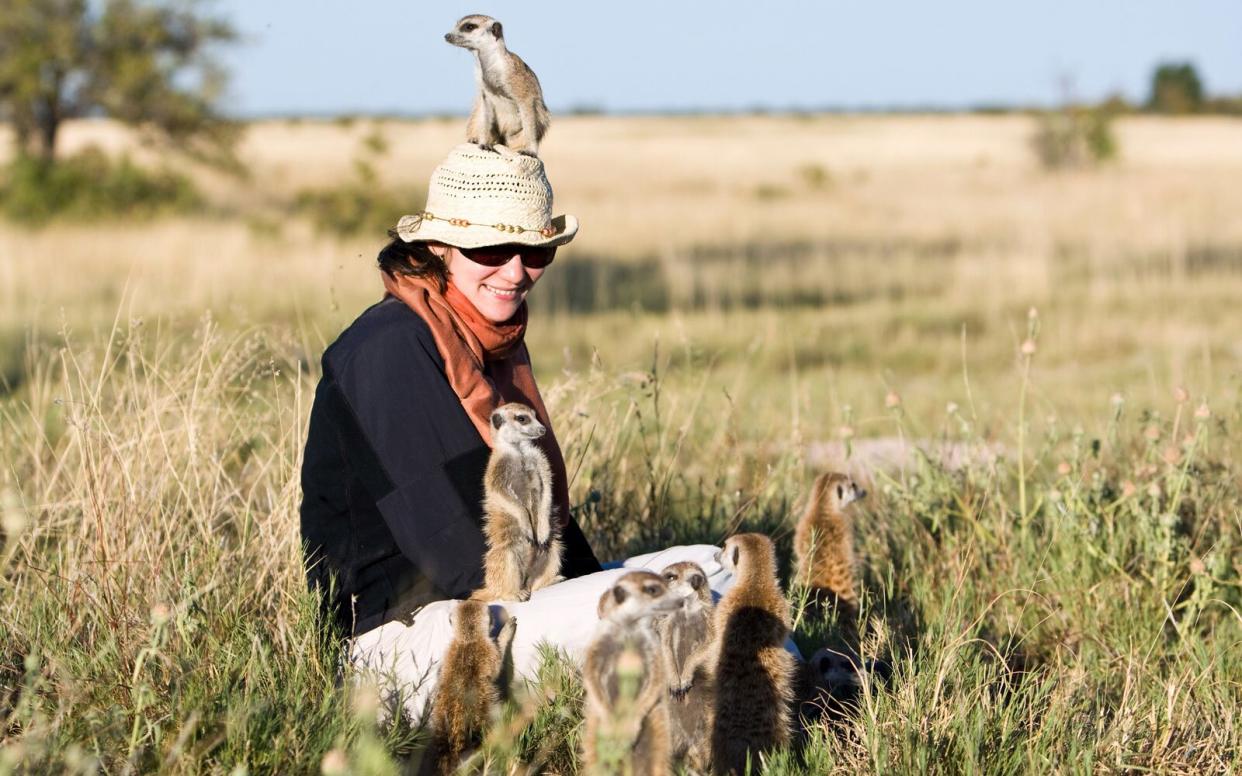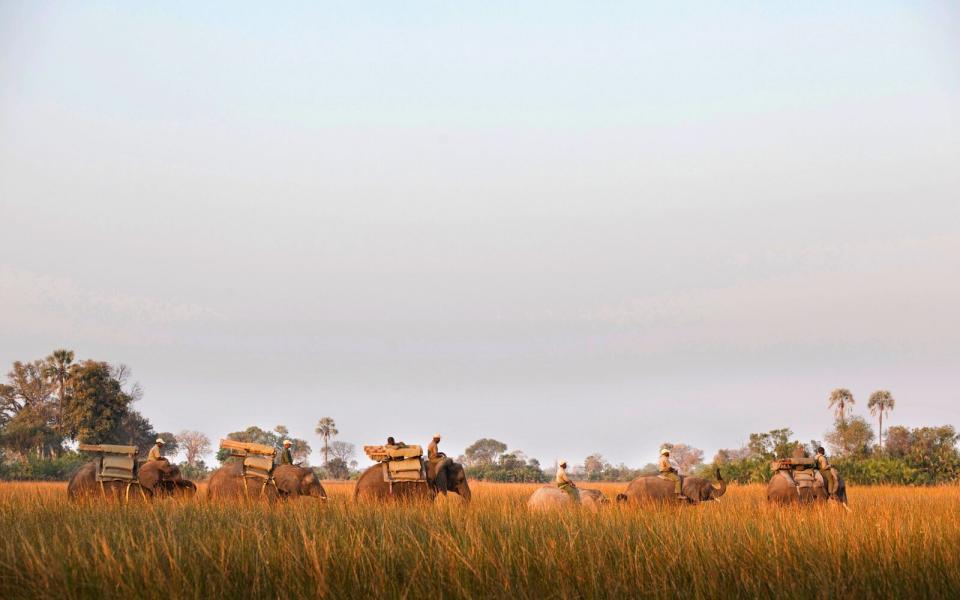Safari Camps Where Animals Are So Close You Can Touch Them

Barcroft Media / Getty Images
“Sit here,” Chaba says. “And stay still. Imagine you’re a termite mound.”
The sun is just beginning to light up the eerily white Makgadikgadi salt flats when I make like a mound. It’s quiet—deafeningly so—until I hear a series of squeaks coming from behind me. The meerkats are awake and slowly emerging from their underground den. Suddenly, a self-appointed sentinel looks up at me with tiny spectacled eyes before climbing up my body—all the way to the top of my head, where he stands guard.
My only movement comes in the form of a smile, one I can’t wipe from my face for the rest of the morning. I traveled to Jack’s Camp in this remote stretch of the Kalahari Desert to see meerkats up close, and here I am watching the sunrise with one on my head.
Even though Jack’s is sublime—think Hemingway’s Africa plus the sumptuous textiles that would’ve adorned the tent of a traveling maharajah—I doubt many first-time safari-goers end up in the barren land encircling camp. They’re in the Serengeti, Maasai Mara, or Kruger National Park spotting the big five. There are no rhinos here. No Cape buffalo. And I don’t think I’ll see any leopards. This place is all about meerkats—the energetic little carnivores made famous by Animal Planet’s Meerkat Manor.

Cultura Travel / Getty Images
According to safari outfitter Ker & Downey, Jack’s Camp and its nearby siblings—San Camp and Camp Kalahari—are the only places in the world where wild meerkats use travelers for lookout points (like termite mounds, we offer heightened vantage points for spotting predators). The meerkats living near camp became habituated to humans 13 years ago when researchers from Cambridge and Cape Town Universities came to Jack’s to study meerkat behavior. They never envisioned a mutually beneficial relationship with the vocal creatures, but the ingenious meerkats hopped aboard, paving the way for the unique experience I enjoyed during a recent trip to Botswana.
And it wasn’t my only Jane Goodall moment. Although I love seeing wildlife in abundance—I’ll never forget sitting in my plunge pool at Singita Sasakwa watching herds of animals trek across the Serengeti below—there’s nothing as thrilling as a close encounter.
My first occurred several summers ago on the same safari that ended at Singita. Before scanning the Serengeti, I checked into Greystoke Mahale in western Tanzania.
It’s situated just below the Mahale Mountains on the banks of Lake Tanganyika, a body of water so vast and clear, it could be a tropical ocean. In the forest beyond camp, wild chimpanzees can be seen going about their daily rituals: foraging for food, swinging from tree branches, and fighting over troop hierarchy. Even though the chimps are wild, they tolerate our presence because, like the meerkats near Jack’s, they’ve been observed by zoologists for years. Though scientists spend long stretches of time in their presence, Greystoke guests are only permitted an hour of viewing per day, a treat that’s often hard-earned. Chimps move around during daylight hours, build new nests every night, and sometimes ascend so high into the mountains guests don’t have the time (or inclination) to look for them. But when you finally spot one, an eerie sense of familiarity envelops you… until fear takes over. Chimps aren’t meerkats; you don’t want one touching your head.
I experienced the same awe when I met a semi-wild herd of elephants at Abu Camp in Botswana’s Okavango Delta. Like Jack’s and Greystoke, Abu offers animal interaction in addition to luxurious lodgings, but Abu’s story is more complex: It began in the 1990s when an American circus trainer vowed to return previously exploited elephants to their natural habitat. Though he successfully brought three pachyderms to Botswana, and later welcomed a handful of African-born orphans, he put his animals to work as he pioneered Africa’s first elephant-back safari.

Singita
Under new ownership since 2004, Abu says it’s planning to phase out elephant rides, and the six current residents now spend most of the day behaving like wild animals in the bush—in fact, one female is thought to be pregnant with a calf sired by a wild bull. Members of the herd are free to leave camp permanently whenever they please. Though their loyal handlers typically facilitate (or at least foresee) the transition, a juvenile male once struck off for the day and never came back. Staff at Abu say they regret his impromptu departure but only because they would have radio collared him first (Abu often partners with Elephants Without Borders, a conservation organization headquartered in a nearby research camp).
But, for the time being, guests can still sit atop the world’s largest terrestrial animal as it ambles through the bush. Travelers can also walk with the elephants, listen to their nighttime rumbles from an elevated star bed positioned above their enclosure, and watch the magnificent creatures wade through the marshy delta while gliding along in wooden mokoro boats. Sitting inside the slender vessel—elephants in front, beside, and behind me—I was mesmerized by their movements through the water and the gentle sounds they made. A few minutes before we reached camp, undoubtedly knowing that she was preparing to go home for the evening, a young orphan named Paseka plunged beneath the water’s surface, clumsily swishing her body to and fro. The more mature females stopped for a snack of reeds and patiently waited as their playful friend relished the day's final rays of sunshine.

